The London Taxi Corporation Ltd trading as the London Taxi Company v Frazer-Nash Research Ltd and Another
| Jurisdiction | England & Wales |
| Judge | The Hon Mr Justice Arnold |
| Judgment Date | 20 January 2016 |
| Neutral Citation | [2016] EWHC 52 (Ch) |
| Court | Chancery Division |
| Docket Number | Case No: HC-2014-002085 |
| Date | 20 January 2016 |
[2016] EWHC 52 (Ch)
IN THE HIGH COURT OF JUSTICE
CHANCERY DIVISION
Rolls Building
Fetter Lane, London EC4A 1NLL
The Hon Mr Justice Arnold
Case No: HC-2014-002085
Douglas Campbell (instructed by Browne Jacobson LLP) for the Claimant Mark Platts-Mills QC and Philip Roberts (instructed by Berwin Leighton Paisner LLP) for the Defendants
Hearing dates: 17–20, 23 November 2015
MR JUSTICE ARNOLD:
Contents
| Topic | Paragraphs |
| Introduction | 1–5 |
| The Fairway, TX1, TXII and TX4 | 6–9 |
| The Trade Marks | 10–12 |
| The new Metrocab | 13–14 |
| The witnesses | 15–26 |
| LTC's witnesses | 15–21 |
| The Defendants' witnesses | 22–26 |
| General factual background | 27–75 |
| Terminology | 28–30 |
| A brief history of London taxis | 31–57 |
| Factors affecting drivers' choices of taxi models | 58–59 |
| Legal and regulatory requirements for London taxis | 60–64 |
| The attitude of the PCO, TfL and Mayor of London to the design of London taxis | 65–68 |
| The Mayor of London's Air Quality Strategy | 69–71 |
| Private hire vehicles | 72–75 |
| LTC's conventional trade marks | 76–77 |
| Reception of the Vito by drivers and passengers | 78–81 |
| The design of the new Metrocab | 82–140 |
| Promotion of the new Metrocab | 141–143 |
| Trial of the new Metrocab | 144–145 |
| Production of the new Metrocab | 146 |
| Do the Defendants intend to deceive the Public? | 147–148 |
| Potential collaboration between LTI and FNR in 2005 | 149 |
| The design of the TX5 | 150–154 |
| The incident involving Mr Zeghibe | 155 |
| Key legislative provisions | 156–158 |
| The average consumer | 159–163 |
| The law | 159 |
| The average consumer in the present case | 160–163 |
| Validity of the Trade Marks: distinctive character | 164–208 |
| Inherent distinctive character | 165–172 |
| The relevant date | 173 |
| Assessment: the CTM | 174 |
| Assessment: the UKTM | 175 |
| Acquired distinctive character | 176–195 |
| The law | 176–178 |
| The relevant date | 179 |
| Assessment | 180–181 |
| The market share held by goods bearing the mark | 182 |
| How intense, geographically widespread and longstanding the use of the mark has been | 183 |
| The amount invested by the proprietor in promoting the mark | 184–187 |
| Evidence from trade and professional associations | 188 |
| Opinion polls | 189 |
| The proportion of the relevant class of persons who, because of the mark, identify the goods or services as emanating from the proprietor | 190 |
| Overall | 191 |
| LTC's case with respect to consumers of taxi services | 192–194 |
| Conclusion | 195 |
| Validity of the Trade Marks: substantial value | 196–215 |
| The law | 197–209 |
| The relevant date | 210 |
| Assessment | 211 |
| The UKTM | 212–214 |
| The CTM | 215 |
| Revocation of the CTM | 216–239 |
| Use of the CTM itself | 217 |
| The law with respect to genuine use | 217–219 |
| The law with respect to sales of used (i.e second-hand) goods | 220–226 |
| The law with respect to genuine use in the Community | 227–230 |
| LTC's evidence of use | 231 |
| Assessment | 232–234 |
| Use of the CTM in a form differing in elements which do not alter its distinctive character | 236 |
| The law | 236 |
| Assessment | 237–238 |
| Conclusion | 239 |
| Conversion of the CTM | 240 |
| Relevant date for assessment of the issues on infringement of the Trade Marks | 241 |
| Approach to the issues on infringement | 242 |
| Infringement of the Trade Marks under Article 9(1)(b)/ | 243–262 |
| Article 5(1)(b) | |
| The law | 243–245 |
| Assessment | 246 |
| The average consumer | 247–248 |
| The distinctive character of the Trade Marks | 249 |
| Comparison of goods | 250 |
| Comparison of signs | 251–259 |
| Has there been actual confusion? | 260–261 |
| Overall assessment | 262 |
| Infringement of the Trade Marks under Article 9(1)(c)/Article 5(2) | 263–269 |
| The law | 263 |
| Assessment | 264 |
| Reputation of the Trade Marks | 264 |
| Link | 265 |
| Detriment to the distinctive character of the Trade Marks | 266 |
| Unfair advantage | 267 |
| Due cause | 228 |
| Conclusion | 269 |
| Defence under Article 12(b)/Article 6(1)(b) | 270–283 |
| Characteristics | 271 |
| Honest practices in industrial and commercial matters | 272–293 |
| Whether the defendant knew of the existence of the trade mark | 273 |
| Whether the defendant used the sign complained of in reliance on competent legal advice | 274 |
| The nature of the use complained of | 275 |
| Whether the defendant knew that the trade mark owner objected to the use of the sign complained of | 276 |
| Whether the defendant knew, or should have appreciated, that there was a likelihood of confusion | 277 |
| Whether there has been actual confusion, and if so whether the defendant knew this | 278 |
| Whether the trade mark has a reputation, and if so whether the defendant knew this | 279 |
| Whether the defendant's use of the sign complained of interferes with the owner's ability to exploit the trade mark | 280 |
| Whether the defendant has a sufficient | 281 |
| justification for using the sign complained of | 281 |
| The timing of the complaint from the trade mark owner | 282 |
| Conclusion | 283 |
| Passing off | 284–298 |
| The law | 284–303 |
| Assessment | 291–298 |
| Goodwill | 292–295 |
| Misrepresentation | 296 |
| Damage | 297 |
| Conclusion | 298 |
| Summary of principal conclusions | 299 |
Introduction
This is a claim for trade mark infringement and passing off. The Claimant ("LTC") is the successor in title to the manufacturer of the Fairway, TX1, TXII and TX4 models of London taxi. The Defendants are the successors in title to the manufacturer of the Beardmore, Oxford and Metrocab models of London taxi. LTC owns trade mark registrations for the shapes of the Fairway and of the TX1/TXII respectively ("the Trade Marks") and claims goodwill in the shapes of all four models. It alleges that the Defendants threaten to infringe the Trade Marks and to commit passing off by marketing a new model of London taxi referred to as the new Metrocab which is currently being trialled. (Strictly speaking, it is the Second Defendant ("Ecotive") which threatens to do this, while the First Defendant ("FNR") will supply parts for the new Metrocab, and in particular the powertrain; but nothing turns on this.)
LTC's complaint concerns the shape of the Defendants' taxi, which it contends has been substantially copied from the shape of the TX4, yet it advances no claim for infringement of any registered design, design right or copyright. Furthermore, LTC alleges that the Defendants intend to deceive the public as to the origin of the new Metrocab by adopting a shape which closely resembles that of LTC's models, which is an allegation of fraud. Unsurprisingly, these allegations have increased the temperature, as well as the duration and expense, of the dispute.
LTC claims infringement of the Trade Marks on three alternative bases as well as passing off. The Defendants deny trade mark infringement and passing off. Furthermore, they contend that the Trade Marks are invalidly registered because they lack distinctive character and add substantial value to the goods. In the alternative the Defendants contend that the CTM should be revoked for non-use. LTC relies upon acquired distinctive character and disputes the allegation of non-use on two different bases. As a result, a considerable number of issues have been raised for decision.
Although counsel for LTC addressed passing off first in his submissions, I have found it more convenient in this judgment to consider the issues in the conventional order, which involves dealing with the trade mark issues first.
I had the advantage of being able to inspect examples of the Fairway, TX1, TXII, TX4 and new Metrocab side by side during the trial. This assisted me to understand some of the evidence, but I have borne in mind that, as explained below, the side-by side comparison is not the one that matters for the purposes of trade mark infringement or passing off.
The Fairway, TX1, TXII and TX4
The Fairway is shown below:
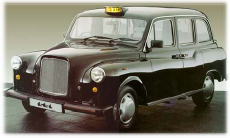
The TX1 is shown below:
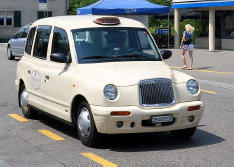
The exterior appearance of the TXII was essentially the same as that of the TXI.
The TX4 is shown below:
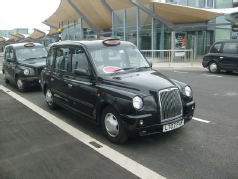
The Trade Marks
LTC is the registered proprietor of Community Trade Mark No. 951871 registered as of 5 October 1998 in respect of "motor vehicles, accessories for motor vehicles; parts and fittings for the aforesaid" in Class 12 ("the CTM"). The specification of the CTM also extends to goods in Classes 6, 16, 18, 21 and 28, but they are not in issue. The CTM is a three-dimensional trade mark represented as follows:

LTC is also the registered proprietor of United Kingdom Trade Mark No. 2440659 registered as of 1 December 2006 in respect of "cars; cars, all being taxis" in Class 12 ("the UKTM"). The UKTM is a three-dimensional trade mark represented as follows:

The same six representations also form the subject-matter of LTC's UK Registered Design No.2069313, which is not relied upon by LTC in these proceedings.
The new Metrocab
The new Metrocab is shown below:
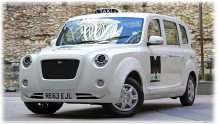

The new Metrocab is shown next to a TX4 below:
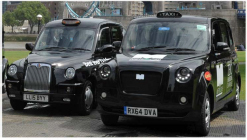
The witnesses
LTC's witnesses
LTC adduced evidence from 12 witnesses, who can be grouped into four categories, as follows.
First, LTC internal witnesses:
i) Peter Johansen is the Chief Executive Officer of LTC, but has only been involved in the business since 2012. He was LTC's principal witness in support of the claim to goodwill in the shape of the LTC taxis, which he did primarily by exhibiting a wide range of documentary evidence. He also gave evidence as to the use of the CTM based on LTC's records.
ii) Paul Woolley is the Chief Operations...
To continue reading
Request your trial-
W3 Ltd v Easygroup Ltd
...there has been genuine use of a trade mark established by the case law of the CJEU in London Taxi Corp v Frazer-Nash Research Ltd [2016] EWHC 52 (Ch), [2016] ETMR 18 at [219] in a manner which was not criticised on appeal as follows (citations omitted): “(1) Genuine use means actual use of ......
-
Pathway IP Sarl (formerly Regus No. 2 Sarl) v Easygroup Ltd (formerly Easygroup IP Licensing Ltd)
...is sufficient to refer to the summary provided by Arnold J in The London Taxi Corp Ltd (t/a London Taxi Co) v Frazer-Nash Research Ltd [2016] EWHC 52 (Ch); [2016] FSR 20 (“the London Taxi case”), at [217] – [219], whose judgment was affirmed on appeal. This summary was recently applied by ......
-
Abanka D.D v Abanca Corporación Bancaria S.A.
...of the relevant principles from The London Taxi Corporation Ltd (t/a The London Taxi Company) v. Fraser-Nash Research Ltd & another [2016] EWHC 52 (Ch) at [217]–[219] as follows: "217. In Stichting BDO v BDO Unibank Inc [2013] EWHC 418 (Ch), [2013] FSR 35 I set out at [51] a helpful summa......
-
Lidl Great Britain Ltd v Tesco Stores Ltd
...commercial exploitation of the mark on the market for the relevant goods or services (see London Taxi Corp v Frazer-Nash Research Ltd [2016] EWHC 52 (Ch), [2016] ETMR 18, per Arnold J at [219]). This has nothing to do with intention. A proprietor may well intend to use a mark but if it has......
-
When are shapes sufficiently distinctive to function as trade marks?
...high a bar to clear. London Taxi The London Taxi Corporation Ltd (t/a The London Taxi Company) v Frazer-Nash Research Ltd and another [2016] EWHC 52 (Ch), 20 January 2016 In the first High Court Decision, Mr. Justice Arnold, concluded that the shape of the traditional London taxi was not su......
-
GAP's Unused Trade Mark Advantageous In Opposing Third Party Application
...the public, the 'average consumer' included members of the public. It is noteworthy that in The London Taxi Corporation v Frazer-Nash [2016] EWHC 52 (Ch), Arnold J reached the opposite conclusion. He accepted that there was authority for end users of goods being relevant consumers, but in t......
-
Brexit and your EU trade marks – time for an IP audit
...29 June 2015 2) See, for example, The London Taxi Corporation Ltd (t/a The London Taxi Company) v Frazer-Nash Research Ltd & Anor [2016] EWHC 52 (Ch), and Appointed Person Decision O/222/16 in the matter of Nike Innovate CV and Intermar 3) Leno Merken BV v Hagelkruis Beheer BV, C-149/11 Pau......
-
Territorial overlaps in trademark law: the evolving European model.
...EU Trademark Law--A Model for Other Regions?, 103 Trademark Rep. 775 (2013). (3) See, e.g., London Taxi Corp. v Frazer-Nash & Anor [2016] EWHC (Ch) 52 (4) See Case G661/11, Martin Y Paz Diffusion SA v. Depuydt, 2013 E.C.R. 577, J 61; Lego Juris, 2010 E.C.R. 1-8403, [paragraph] 61; Joine......
-
DISENTANGLING FUNCTIONALITY, DISTINCTIVENESS AND USE IN AUSTRALIAN TRADE MARK LAW.
...18 March 2015) ('Consorzio Origini'). (258) As summarised by Arnold J in The London Taxi Corporation Ltd v Frazer-Nash Research Ltd [2016] EWHC 52 (Ch), 'it is the shape itself which must add substantial value to the goods and that goodwill derived from sales and advertising is not relevant......

